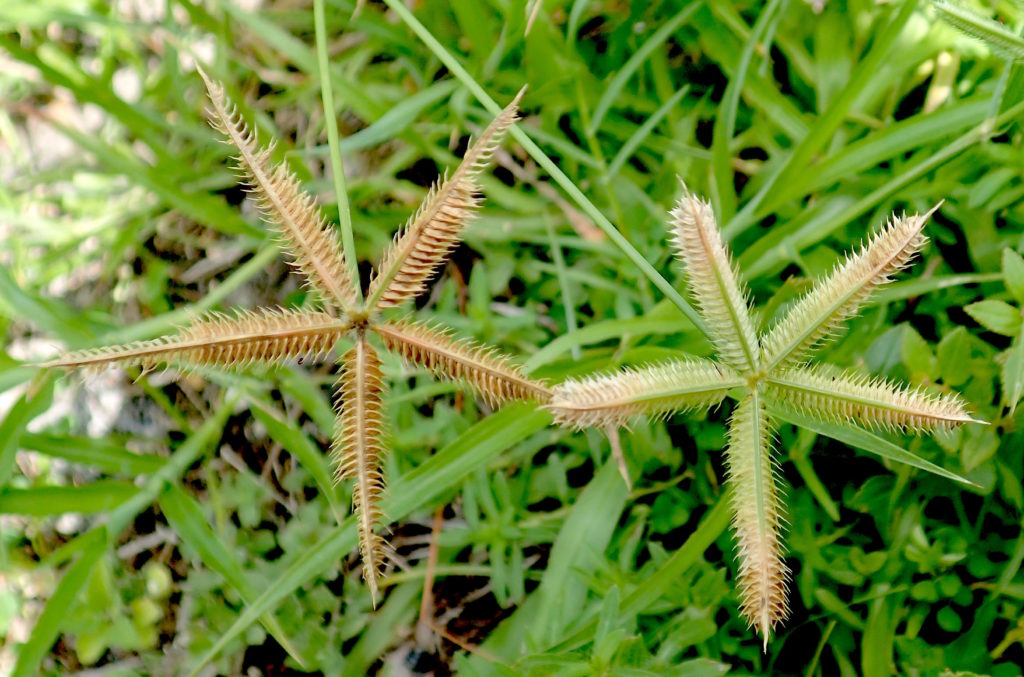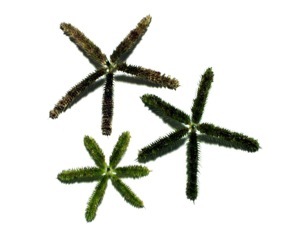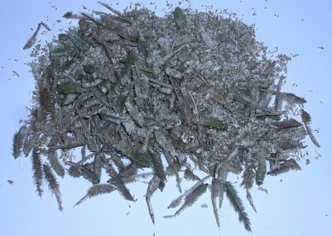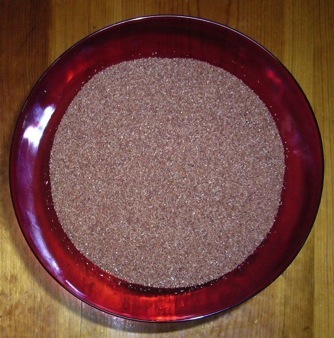Dactyloctenium aegyptium: Staple Grain
Grasses can be a pain in the …ah… grass…
First, books about grasses are few and incredibly expensive. Next, grasses are hard to identify, often minute differences tells one species from another, and the language can be a bit of a challenge. Here is a partial description of the Crowfoot Grass:
FLORETS: Fertile florets appressed to rhachilla. Fertile lemma gibbous; ovate in profile; 2.6–4 mm long; membranous; keeled; three-veined. Lemma midvein scaberulous. Lemma lateral veins obscure. Lemma apex acute, or cuspidate; muticous, or mucronate. Palea one length of lemma; two-veined. Palea keels wingless, or winged; narrowly winged. Apical sterile florets resembling fertile though underdeveloped.
Did you get that? I call it Helicopter Grass, all the “fingers” are on the same plane like a helicopter’s rotor. The seeds are on the underside, like teeth on a comb.
Crowfoot grass, Dactyloctenium aegyptium (dak-tie-lok-TEE-nee-um ee-YIP-tee-um) is a
traditional food in Africa and highly nutritional. I like it as a trail side nibble but in season it is not difficult to collect enough for a side dish for one or two people or larger amounts for storage. It’s about the size of table salt grains though golden in color. I eat it raw or cooked. It has the texture of sand, but tasty, edible sand. It is an extremely versatile grain and can be cooked as it, roasted, milled et cetera. I eat it raw on the trail but I also like to mix it with some water and olive oil, cook for about 10 minutes or until the water is evaporated and enjoy. Raw or cooked it has about the same flavor and texture. I suspect it is not a popular food because of its size and texture, which of course is significantly changed if milled into flour. As flour is by far its best use, in my opinion
The only problem I’ve had with Crowfoot Grass is that while long it grows “up” only about a foot and can get dirt in with the grains. To harvest, I simply tug at the seed heads. If they let go, they
are ready, if not leave them because when green the seeds are not ready to eat. I separate the grain from the hulls by rubbing the seed heads in my hand. Rub them a lot. I pick or screen away the larger chaff and then gently blow away the rest, leaving a pile of gold/orange grain. Do not eat the grass itself (as opposed to the seeds.) In hot weather the grass itself can be toxic like Sorghum. Also it is reported that its roots can be chewed like sugar cane. I do not know. I have not tried it. You’re on your own with that one. I would not try the root in hot weather.
Dactyloctenium is from Greek and means finger and little comb, referring to the “flower”
spreading like fingers and the seeds lining up like teeth on a comb. Aegyptium, of Egypt. Greeks would say it with one more syllable than the Latin: ah-ee-YIP-tee-um. There are 14 members in the genus.
On the plus side there are few toxic grasses in North American, though Sorghum is one (the leaves, not the seeds or the sap.) Some grasses are distinct, however, and crowfoot grass is one of them. It’s easy to spot and there are no look alikes.
In my video about Crowfoot Grass I mixed one ounce of seed flour with one ounce of white flour, a teaspoon of sugar, a quarter teaspoon of salt, half a teaspoon of baking powder, tea teaspoons of olive oil and about a quarter cup of water.
Green Deane’s “Itemized” Plant Profile
IDENTIFICATION: Spreading, creeping and mat-forming grass, roots at the lower nodes. The flower head has two to seven spikelets — usually five or six — on the tip of the stem. Seed head looks like a crow’s foot, each plant can have 60,000 seeds.
TIME OF YEAR: Fall in all areas, when the top separates easily from the stem. Ranges from Maine to California. While seeds can be collected when ripe never eat the grass itself in hot weather.
ENVIRONMENT: Heavy, damp soil to dry, sandy arid soil
METHOD OF PREPARATION: Used like any grain, but because of its size and texture better used as a flour. I eat them raw on the trail or boil them for a few minutes. Green seeds are not edible but can be bruised and used as a fish stupefier. Do not eat unripe seeds.






Does this grass grow in Illinois? Also, do you have any information about the edibility of Reed Canary Grass (phalaris arundinacea)?
It is reported in St. Clair county in that state. I have not information on any Phalaris.
Reed Canarygrass seed is recorded as having been consumed as a parched grain by native american groups. I recently gathered and winnowed a small amount and, finding it easy, will be gathering a much greater quantity shortly. I’ll report back following experiments with eating the stuff.
hello mr dean how are u in the Bahamas we have plenty cow foot grass
I never no they could eat
have a great day an GOD BLESSING
Can I ask what hand grinder you use for such small seeds? Secondly could a coffee grinder work to pound the seeds?
Yes, a coffee grinder would work. They are very fragile.
what are the nutrient benefits we can get from that? are we gonna be able to use it like pepper, chilly powder et cetera?
One uses it like wheat.
Can I buy it from the store as a flour already? if so where?
Great youtube Chanel I just tuned in.
I HAVE COASTAL GRASS, THAT I HAVE BEEN BAILING FOR HAY FOR RACING HORSES, BUT NOW I HAVE A LOT OF CROWFOOT GRASS COMING UP. HOW DO I GET RID OF THE CROWFOOT GRASS, THEY DON’T
WANT OTHER GRASS WITH COASTAL? THANKS, RALPH